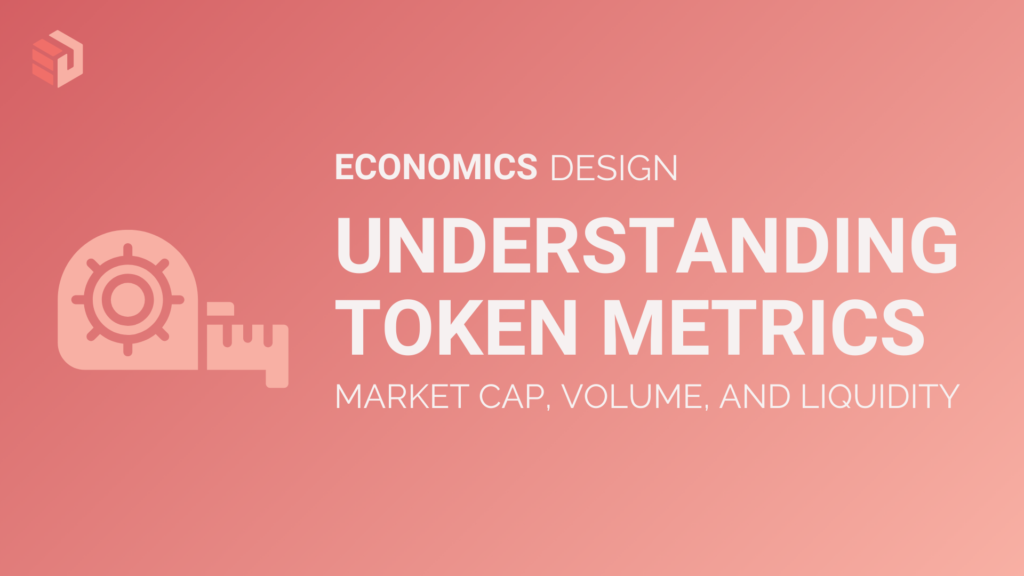
Tokenomics is a crucial aspect of the cryptocurrency market that investors should understand before investing in any token.
Tokenomics refers to the economic models behind a cryptocurrency token or crypto asset, including factors such as total supply, initial distribution, vesting periods, utility, burn mechanisms, and economic stability. In this blog, we will discuss the three key metrics that investors should monitor to understand a token’s value and potential growth in the market: market cap, trading volume, and liquidity.
What is market cap?
Market capitalisation, or market cap, is the total value of a token’s circulating supply, usually measured in US dollar terms. It is a crucial metric that investors use to evaluate a token’s worth and potential for growth in the market. The higher a token’s market cap and lower its circulating supply, the more valuable it could be in the future.
How is market cap calculated?
Market cap is calculated by multiplying a token’s circulating supply by its current market price. For example, if a token has a circulating supply of 1 million and a current market price of $10, its market cap would be $10 million. Companies are typically divided according to market cap, such as large-cap ($10 billion or more), mid-cap ($2 billion to $10 billion), and small-cap ($300 million to $2 billion).
Why is market cap important for investors?
Market cap is an essential metric for investors because it provides insight into a token’s overall value and potential for growth in the market. A higher market cap indicates that more investors are interested in the token, which could lead to increased demand and higher prices in the future. Additionally, market cap can help investors diversify their portfolios by investing in companies of different sizes.
Market cap vs. free-float market cap
Market cap is based on the total value of all a company’s shares of stock, including both publicly traded shares and restricted shares held by company officers and insiders.
On the other hand, float-adjusted market cap (sometimes called free-float market cap) is calculated using only shares that are available to the general public, excluding locked-in shares, such as those held by institutions and government agencies.
Many major stock indexes like the S&P 500 and the Dow Jones Industrial Average use float-adjusted market cap, as do many index funds and exchange-traded funds.
What is trading volume?
Trading volume refers to the total number of shares or contracts that are traded for a specified security during a specified time period, usually measured in a day. It is a crucial metric that investors use to evaluate a security’s liquidity and demand in the market.
Trading volume can be measured on any type of security traded during a trading day, including stocks, bonds, options contracts, futures contracts, and all types of commodities. Each market exchange tracks its trading volume and provides volume data, which is reported as often as once an hour throughout the current trading day.
These hourly reported trade volumes are estimates, and a trade volume reported at the end of the day is also an estimate. Final actual figures are reported the following day.
How does trading volume affect a token’s price and liquidity?
High trading volume indicates that a token is in high demand, which could lead to increased prices and liquidity in the market. Conversely, low trading volume could indicate that a token is not in high demand, which could lead to decreased prices and liquidity.
What is liquidity?
Liquidity refers to the ease with which an asset or security can be converted into ready cash without significantly affecting its market price. In other words, it describes the degree to which an asset can be quickly bought or sold in the market without affecting its price.
Cash is the most liquid asset, while tangible items are less liquid. Liquidity is crucial for both individuals and businesses, as it determines how quickly and easily a financial asset or security can be converted into cash without losing significant value.
Strategies for increasing liquidity in a token
There are several strategies that token issuers can use to increase liquidity in a token, including:
- Market-making: This involves creating buy and sell orders for a token to increase its trading volume and liquidity.
- Liquidity mining: This involves incentivising users to provide liquidity to a token’s market by offering rewards in the form of additional tokens.
- Listing on multiple exchanges: Listing a token on multiple exchanges can increase its exposure to potential investors and increase its liquidity.
In conclusion
Monitoring market cap, trading volume, and liquidity is crucial for investors to understand a token’s value and potential for growth in the market. A high market cap, high trading volume, and high liquidity indicate that a token is in high demand and could lead to increased prices and growth in the future.
Conversely, low market cap, low trading volume, and low liquidity could indicate that a token is not in high demand, which could lead to decreased prices and growth. Therefore, investors should carefully monitor these metrics before investing in any token.
